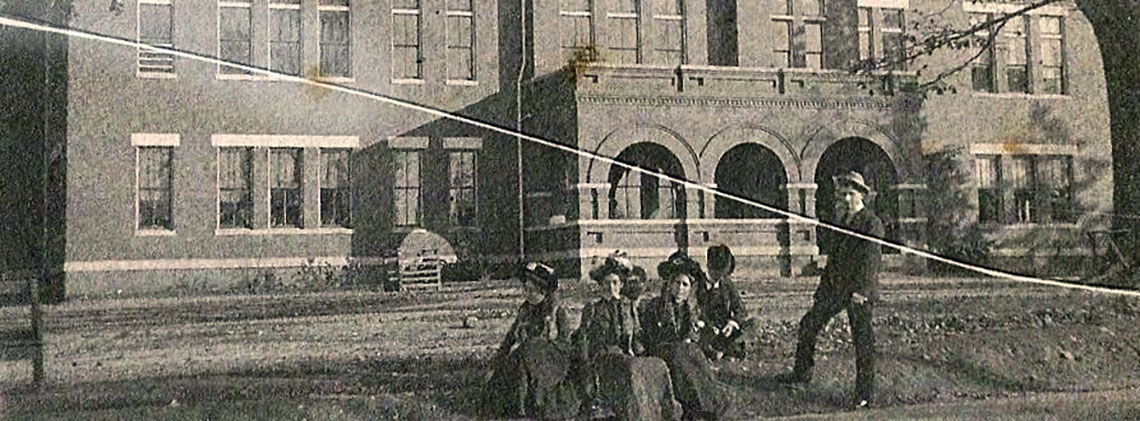North Alexander School History
- Home
- North Alexander School / History

Education has been the town's priority since 1790.
Education in Washington, Georgia was a priority from the town's inception in 1790. Sarah Hillhouse, the first female newspaper publisher in the State of Georgia (and probably in the Southeast), wrote in 1786 that the community already boasted "a good Latin and grammar school." From the early nineteenth century, the Male Academy and the Female Seminary were well-respected institutions of learning. The Male Academy was on the site now occupied by Regions Bank on East Robert Toombs Avenue and the Female Seminary was on North Alexander Avenue.
In the late 1800s, Georgia began emphasizing more widespread public education, with Wilkes County and Washington embracing that development. Bonds were issued on July 1, 1896 in the amount of $15,000 to fund a new public school building for the boys and girls of Washington. Architect R.H. Hunt, one of the most prolific and highly regarded architects in the Southeast, was selected to design what is now the North Alexander School.
The site selected was on North Alexander Avenue near the Female Seminary. The venerable girls' school structure was sold and moved a short distance to the south, and became a private residence. The cost of the School came in $2000 over the bond issue, but the School had sanitary plumbing, central heating and electric lights making it "state of the art" for 1897. The editor of the Washington Gazette was most impressed by the school's woodwork: "natural pine-varnished-curly pine." Local resident Belle Hill King wrote to her niece on January 10, 1897: "The new school house is rapidly nearing completion, and looks beautiful, and big."
In March, 1897 the School was ready for occupancy. The first commencement was held in the second floor auditorium in June of that year, the culmination of a decade of planning and negotiations. By March 1898 there were 250 students. Most pupils were from Washington, but some were boarders at the school's dormitory (possibly the old Female Seminary) and at local residences with arrangements run by the city school board. Distinguished author and botanist Eliza Frances Andrews joined the faculty in the fall of 1898. In the same year, an eleventh grade was added to emphasize the college preparatory goals of the School. In November of 1899, the bell from the old courthouse on the Washington town square was removed from that deteriorating building and placed in the new School. The students were soon publishing their own newspaper.
In 1903-04 Frank Milburn, architect for the new county courthouse, was hired to solve the problems of the School's heating and electrical systems which were failing. E.J. Eberling of Augusta was hired in 1905 to make the necessary repairs and renovations at a cost of $6500.
The School earned a State of Georgia Class I, Group I status in the fall of 1912, the highest classification based on teacher qualifications and thoroughness of curriculum. The second floor auditorium was a popular place not only for School activities but also for community concerts and gatherings. Senior operettas such as "Princess Chrysanthemum" in 1913 and others were performed. Even a grand opera performance by renowned prima donna Bianca Randall was held there in May 1914.
A bond issue in 1916 to expand facilities was soundly defeated, but action became critical with enrollment topping 280 in 1917 and due to urgings from the Southern Association (the regional educational accrediting organization). Washington Mayor K.A. Wilheit championed a bond referendum with $20,000 designated for new school construction. The measure unanimously passed and bids were received in September 1919 for a two-story, eight-room structure to the south of the North Alexander School building. Work commenced in the beginning of 1920 and this building was enlarged in 1949.
The main School building suffered serious roof damage on March 28, 1920 when a tornado wreaked havoc throughout the city. In February, 1922 an electric bell system was installed in the original building. That system was designed by students Jack Burdett and Charlie Lucas.
In 1919 the local Civic League (forerunner of the Washington Women's Club) funded a domestic department for the high school as well as a dark room and tools for the workshop. Fall of 1922 saw the establishment of a science laboratory. In 1930 a combined gymnasium/auditorium/National Guard armory was completed on the north side of the School.
Over time in the twentieth century, small rural schools in Wilkes County were consolidated with the one in Washington and, by the mid-1950s, the North Alexander School facilities were badly strained. Beginning in 1956 the School was used only for students in the first through seventh grades because a new high school had been built on East Street for grades eight through twelve. In 1970 the first African-American students began to attend the North Alexander School and the faculty was integrated.
In 1972, the North Alexander School permanently closed. The main School building was essentially abandoned, becoming little a barely used-storage facility for obsolete equipment. Scant attention was paid to its upkeep and the School slowly deteriorated despite its beauty and grace, great location, famous architect and countless stories.
Parts of the rest of the School campus were used. In 1974 a county-wide public kindergarten program was established in one of the newer buildings on the site. Shortly thereafter, the Washington Little Theater Company made major renovations to the old armory/auditorium and the building is now the home of Washington Little Theater Bolton Lunceford Playhouse. The Wilkes County Board of Education still uses another building as its main office.
